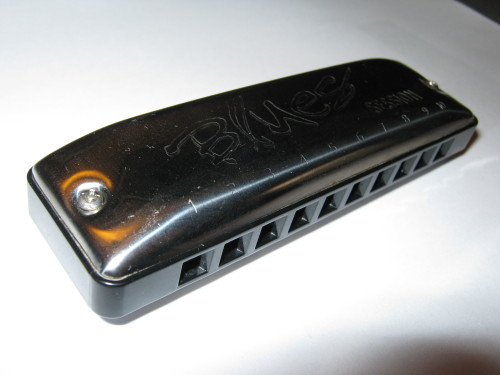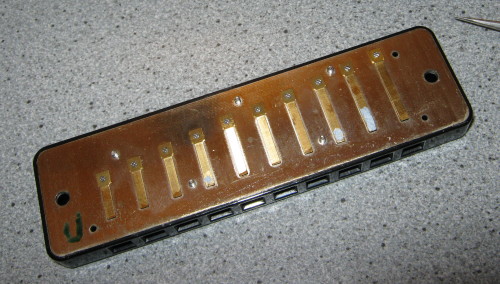Time for a musical tech note.
This is a Seydel Session harmonica, which I've retuned (reversibly) to play the A mixolydian scale, with A as the blow chord and G as the draw chord.
The standard A tuning for diatonic harmonicas — Richter
tuning — gives you A as a blow chord and E7 as a draw chord, with
the notes of the A major scale.
| 1 | 2 | 3 | 4 | 5 | 6 | 7 | 8 | 9 | 10 | |
|---|---|---|---|---|---|---|---|---|---|---|
| A | C# | E | A | C# | E | A | C# | E | A | blow |
| B | E | G# | B | D | F# | G# | B | D | F# | draw |
This harmonica was originally in Paddy Richter tuning, which alters blow 3 from E to F#, extending the scale by a note but changing the blow chord to A6.
| 1 | 2 | 3 | 4 | 5 | 6 | 7 | 8 | 9 | 10 | |
|---|---|---|---|---|---|---|---|---|---|---|
| A | C# | F# | A | C# | E | A | C# | E | A | blow |
| B | E | G# | B | D | F# | G# | B | D | F# | draw |
I hardly ever use this tuning (preferring solo-tuned tremolo harmonicas when I don't need chords), so I thought I'd retune it to something I'd find more useful.
I've also got a Hohner Highlander tremolo harmonica, which uses a different variation on the Richter tuning: the G#s are flattened to G.
| 1 | 2 | 3 | 4 | 5 | 6 | 7 | 8 | 9 | 10 | |
|---|---|---|---|---|---|---|---|---|---|---|
| A | C# | E | A | C# | E | A | C# | E | A | blow |
| B | E | G | B | D | F# | G | B | D | F# | draw |
This lets you play the A mixolydian scale, widely used in Scottish traditional music as it's the scale bagpipes are tuned to. However, the draw chord ends up as Em7 — which is cool for minor blues, but less useful for pipe tunes.
Harmonica reeds are normally tuned by scratching away the metal at one of the ends, or by adding weight using solder. However, harmonica player and maker Brendan Power's web pages mention using Blu-Tak for tuning. This is much easier than the usual approach, and it's reversible, but you can only lower notes this way.
A bit of thought gave a tuning that gives the A mixolydian scale, but has A and G as the blow and draw chords — and that only needed notes to be lowered from the existing Paddy Richter tuning.
| 1 | 2 | 3 | 4 | 5 | 6 | 7 | 8 | 9 | 10 | |
|---|---|---|---|---|---|---|---|---|---|---|
| A | C# | E | A | C# | E | A | C# | E | A | blow |
| B | D | G | B | D | F# | G | B | D | F# | draw |
I found the easiest way to apply the Blu-Tak was with a sharp-nosed pair of tweezers, a very little bit at a time until it's at the right pitch, rounding the edges of the blob so they don't interfere with the reed slot. I used a thin flat-bladed screwdriver to support the reed from inside the chamber.
The draw reeds were much easier to adjust than the blow reeds. (If you started with a standard-tuning harmonica you wouldn't need to touch the blow side at all, of course.) If a reed doesn't work properly to start with, playing it hard usually sorted it out — presumably by blowing out the microscopic bit of Blu-Tak I couldn't remove.
With the covers back on, the resulting harmonica plays just as well as it did before — but now I can play pipe tunes in first position without needing to bend two notes...

